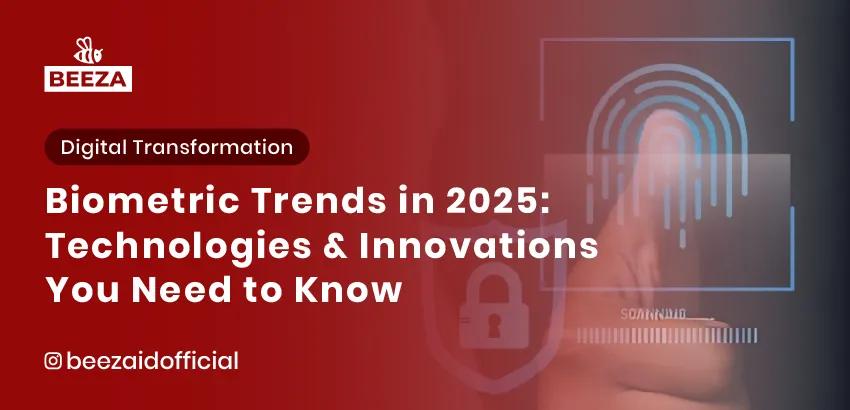
Biometric trends technology is evolving rapidly, shaping how we authenticate identities, secure transactions, and interact with digital services. From facial recognition in smartphones to fingerprint-based payments, biometrics have become an integral part of our daily lives.
As we move into 2025, new biometric innovations are emerging, offering enhanced security, accuracy, and convenience. This article explores the key biometric trends of 2025, how they impact businesses and individuals, and what to expect in the future.
Top Biometric Trends in 2025
1. Multi-Modal Biometrics for Higher Accuracy
🔹 What’s changing?
Traditional biometric authentication (e.g., fingerprints or face recognition) is being replaced by multi-modal biometrics, which combines multiple biometric data points for enhanced security.
✅ Example: A banking app may require facial recognition + voice authentication to verify a transaction instead of just one method.
💡 Why it matters?
- Reduces false acceptance and rejection rates.
- Increases security by making identity fraud more difficult.
- Improves accessibility, allowing users to choose the most convenient authentication method.
2. AI-Powered Behavioral Biometrics
🔹 What’s changing?
Instead of relying on static biometric data (like fingerprints), AI-driven behavioral biometrics analyze a person’s unique behavior patterns, such as keystroke dynamics, mouse movements, and walking gait.
✅ Example: Banks use behavioral biometrics to detect fraud by analyzing how users type their passwords or interact with their mobile banking apps.
💡 Why it matters?
- Provides continuous authentication without disrupting the user experience.
- Enhances fraud detection by identifying anomalous behavior in real-time.
- Reduces reliance on passwords and PINs, making authentication seamless.
3. Contactless Biometrics for a Post-Pandemic World
🔹 What’s changing?
COVID-19 accelerated the shift to contactless solutions, and in 2025, contactless biometrics will dominate industries like travel, healthcare, and finance.
✅ Example: Airports are deploying facial recognition gates for seamless, touch-free immigration clearance.
💡 Why it matters?
- Improves hygiene and convenience by eliminating the need for physical contact.
- Speeds up verification processes in high-traffic areas.
- Supports large-scale deployments in public transport, banking, and healthcare.
4. Biometric Payments on the Rise
🔹 What’s changing?
Forget PIN codes and OTPs—2025 will see an increase in biometric payment systems, where users authorize transactions with their face, fingerprint, or voice.
✅ Example: Mastercard and Visa are launching “Smile-to-Pay” facial recognition payment systems at retail stores.
💡 Why it matters?
- Reduces fraud in online and offline transactions.
- Makes payments faster and more secure.
- Enhances user convenience, eliminating the need for passwords or cards.
5. Blockchain-Backed Biometric Security
🔹 What’s changing?
Biometric data security is a major concern. Blockchain technology is now being integrated to store and verify biometric credentials securely without centralized databases.
✅ Example: Companies are building decentralized identity systems, allowing users to own and control their biometric data.
💡 Why it matters?
- Prevents data breaches and unauthorized access.
- Empowers users to control their personal information.
- Enhances transparency in identity verification systems.
6. Voice Biometrics for Customer Service & Authentication
🔹 What’s changing?
Voice recognition technology is advancing, making it a mainstream biometric authentication method in customer service, banking, and healthcare.
✅ Example: Banks and telecom companies now use voice authentication instead of security questions to verify callers.
💡 Why it matters?
- Enhances security by analyzing voice patterns, pitch, and tone.
- Reduces fraud in call centers and phone-based transactions.
- Offers a hands-free authentication experience for users.
7. Biometric Wearables for Continuous Authentication
🔹 What’s changing?
Smartwatches and fitness trackers are evolving to include biometric authentication features, such as heart rate recognition and electrocardiogram (ECG) verification.
✅ Example: Apple and Samsung are integrating biometric authentication into smartwatches for secure payments and device unlocking.
💡 Why it matters?
- Enables continuous authentication, ensuring security without manual input.
- Reduces the risk of stolen credentials.
- Enhances accessibility for users who struggle with traditional biometrics.
Industries Benefiting from Biometric Innovations in 2025
🔹 Banking & Finance
- Biometric payments replace passwords and PINs.
- Behavioral biometrics detect fraudulent transactions.
🔹 Healthcare
- Patients use facial recognition for secure medical record access.
- Contactless biometrics streamline hospital check-ins.
🔹 Travel & Hospitality
- Airports adopt AI-powered face recognition gates.
- Hotels implement biometric check-ins to replace keycards.
🔹 E-Commerce & Digital Services
- Online stores use biometric authentication for purchases.
- Behavioral biometrics prevent account takeovers.
Challenges of Biometric Technology in 2025
1. Privacy and Ethical Concerns
💡 Solution: Implement decentralized biometric storage to give users control over their data.
2. Security Threats (Spoofing & Deepfakes)
💡 Solution: Use liveness detection AI to differentiate real users from fake biometric attempts.
3. Regulatory Compliance Issues
💡 Solution: Businesses must comply with global regulations such as GDPR, CCPA, and new biometric privacy laws.
Future Outlook: What’s Next for Biometrics?
🚀 Biometric Authentication as a Standard – Passwords will become obsolete as biometric security becomes the default for devices and services.
🚀 Brainwave-Based Authentication – Future innovations may use EEG (brain activity) scans as a highly secure authentication method.
🚀 Biometric Smart Cities – Governments will integrate biometrics into public services, transportation, and law enforcement for seamless security.
Conclusion
Biometric technology is transforming security, authentication, and customer experience across industries. As AI, blockchain, and behavioral biometrics advance, we can expect faster, safer, and more seamless interactions in 2025.💡 Looking for a biometric security solution?
Beeza offers cutting-edge biometric authentication and eKYC solutions for businesses. Contact us today to explore how we can help secure your operations! Get in touch with Beeza now!